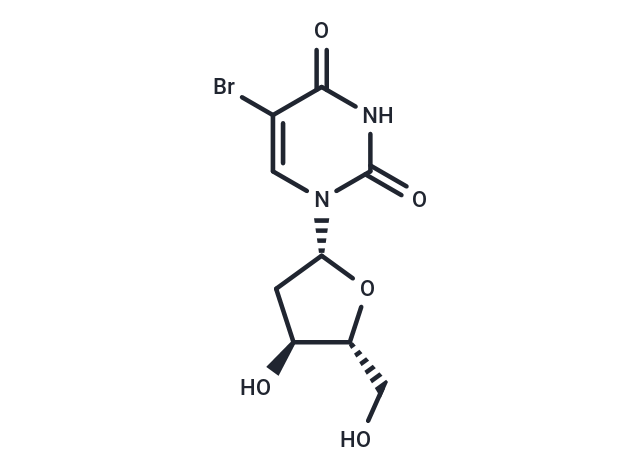Shopping Cart
Remove All Your shopping cart is currently empty
Your shopping cart is currently empty
5-BrdU (Broxuridine) is a nucleoside analogue. 5-BrdU is used to detect proliferating cells and compete with thymidine for incorporation into DNA.

| Pack Size | Price | USA Warehouse | Global Warehouse | Quantity |
|---|---|---|---|---|
| 200 mg | $34 | In Stock | In Stock | |
| 500 mg | $52 | In Stock | In Stock | |
| 1 g | $85 | In Stock | In Stock | |
| 2 g | $125 | - | In Stock | |
| 1 mL x 10 mM (in DMSO) | $29 | In Stock | In Stock |
| Description | 5-BrdU (Broxuridine) is a nucleoside analogue. 5-BrdU is used to detect proliferating cells and compete with thymidine for incorporation into DNA. |
| Targets&IC50 | HepG2 cells:7.8 μM, HepG2 cells (24 h):11 μM, L5178Y cells:20 μM, T24 cells (48 h):17 μM, T24 cells (24 h):47 μM |
| In vitro | METHODS: Mouse neural precursor cells were treated with 5-BrdU, and the cell proliferation activity was detected by MTT. RESULTS: The EC50 value of the anti-proliferation activity of 5-BrdU was 2.045μM. [1] METHODS: L5178Y mouse leukemia cells were treated with 5-BrdU, and the growth inhibition of the cells was determined by growth inhibition. RESULTS: In L5178Y mouse leukemia cells, the IC50 values of 5-BrdU were 20μM (determined by [14C] leucine incorporation) and 26μM (determined by [14C] thymidine incorporation), respectively. [2] |
| In vivo | METHODS: To study the anti-tumor activity of 5-BrdU, 5-BrdU was intraperitoneally injected (300 mg/kg) or orally administered (0.8 mg/mL) in the rat glioma RG2 tumor model. RESULTS: 5-BrdU significantly slowed down the progression of the tumor. [3] METHODS: To study the effect of exposure during the embryonic period on the cerebellar neuroepithelium of mice, pregnant rats were injected with different doses (25-300 µg/g) of 5-BrdU at a single time on the 13th day of the embryo. RESULTS: Low doses (25-75 µg/g) of 5-BrdU did not change the proliferation behavior of cerebellar neuroepithelial cells, while high doses (100-300 µg/g) led to a decrease in related proliferation parameters, among which the effect of the 300 µg/g dose was the most significant. [4] METHODS: To study the effect of 5-BrdU on neuroblasts in the granular layer outside the cerebellum of mice, different doses (50-300 µg/g) of 5-BrdU were injected once on the 9th day after the birth of mice. RESULTS: Different doses of 5-BrdU can affect the duration of each stage of the cell cycle and the completion time of the entire cell cycle. [4] METHODS: To investigate the effect of 5-BrdU on neurogenesis in the hippocampal dentate gyrus of adult rats, adult rats were treated with cumulative doses of 5-BrdU (40, 240 or 460 mg/kg). RESULTS: 5-BrdU did not reduce cell proliferation or the number of immature neurons in the dentate gyrus of the hippocampus. [5] |
| Kinase Assay | Assays are run in the presence of 100 μM ATP using 10 μM of substrate. 30 μL PROTEIN-MIX in 25% DMSO and incubated for 15 min at room temperature. 10 μL PEPTIDE-MIX is added, the mixture is incubated for 60 min at RT and stopped by adding 180 μL 6.4% TCA (final concentration: 5%). Incorporated phosphate is measured in a scintillation counter and IC50 values are calculated using a sigmoidal curve analysis program with variable hill slope[1]. |
| Cell Research | Cultures are initially plated at 2000 cells/cm2 and are quantified with a Z2 Coulter Counter. RG2 rat glioma cells are treated once with 0, 1, 10, or 50 μM BrdU for 24 hours, and cumulative growth curves were obtained over 18 days. Control and treated cells are quantified and replated at equal densities on days 5, 12, and 18 after treatment.(Only for Reference) |
| Synonyms | BUdR, Broxuridine, Bromodeoxyuridine, BRDU, 5-bromo-2'-deoxyuridine |
| Molecular Weight | 307.1 |
| Formula | C9H11BrN2O5 |
| Cas No. | 59-14-3 |
| Smiles | O=C1N([C@@H]2O[C@H](CO)[C@@H](O)C2)C=C(Br)C(=O)N1 |
| Relative Density. | 1.905 g/cm3 |
| Storage | keep away from direct sunlight,store at low temperature | Powder: -20°C for 3 years | In solvent: -80°C for 1 year | Shipping with blue ice/Shipping at ambient temperature. | |||||||||||||||||||||||||||||||||||||||||||||
| Solubility Information | Ethanol: 2 mg/mL (6.51 mM), Sonication is recommended. H2O: 15.4 mg/mL (50.15 mM), Sonication is recommended. DMSO: 242.5 mg/mL (789.65 mM), Sonication is recommended. | |||||||||||||||||||||||||||||||||||||||||||||
| In Vivo Formulation | 10% DMSO+40% PEG300+5% Tween 80+45% Saline: 5 mg/mL (16.28 mM), Sonication is recommended. Please add the solvents sequentially, clarifying the solution as much as possible before adding the next one. Dissolve by heating and/or sonication if necessary. Working solution is recommended to be prepared and used immediately. The formulation provided above is for reference purposes only. In vivo formulations may vary and should be modified based on specific experimental conditions. | |||||||||||||||||||||||||||||||||||||||||||||
Solution Preparation Table | ||||||||||||||||||||||||||||||||||||||||||||||
Ethanol/H2O/DMSO
H2O/DMSO
DMSO
| ||||||||||||||||||||||||||||||||||||||||||||||
| Size | Quantity | Unit Price | Amount | Operation |
|---|

Copyright © 2015-2026 TargetMol Chemicals Inc. All Rights Reserved.